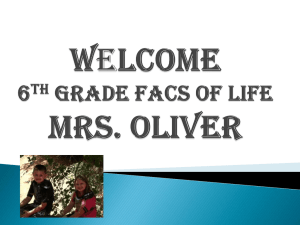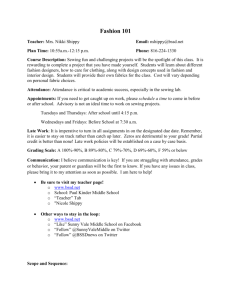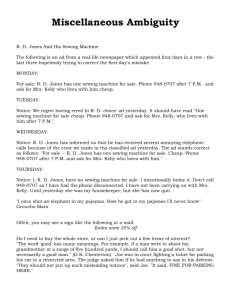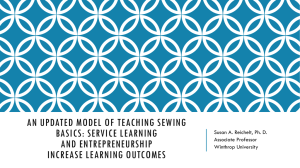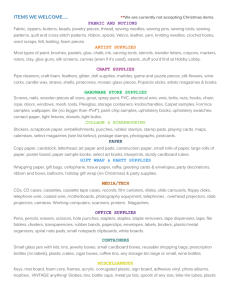District Overview The Family and Consumer Sciences curriculum
advertisement
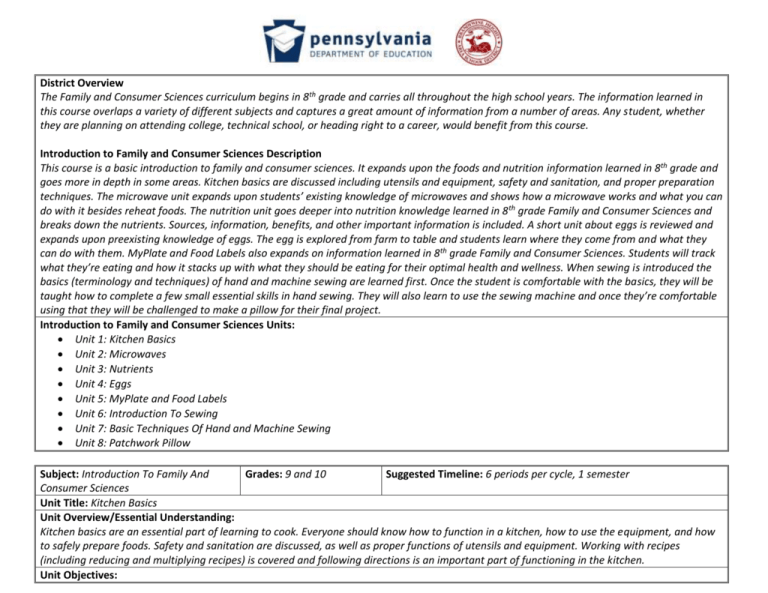
District Overview The Family and Consumer Sciences curriculum begins in 8th grade and carries all throughout the high school years. The information learned in this course overlaps a variety of different subjects and captures a great amount of information from a number of areas. Any student, whether they are planning on attending college, technical school, or heading right to a career, would benefit from this course. Introduction to Family and Consumer Sciences Description This course is a basic introduction to family and consumer sciences. It expands upon the foods and nutrition information learned in 8th grade and goes more in depth in some areas. Kitchen basics are discussed including utensils and equipment, safety and sanitation, and proper preparation techniques. The microwave unit expands upon students’ existing knowledge of microwaves and shows how a microwave works and what you can do with it besides reheat foods. The nutrition unit goes deeper into nutrition knowledge learned in 8 th grade Family and Consumer Sciences and breaks down the nutrients. Sources, information, benefits, and other important information is included. A short unit about eggs is reviewed and expands upon preexisting knowledge of eggs. The egg is explored from farm to table and students learn where they come from and what they can do with them. MyPlate and Food Labels also expands on information learned in 8th grade Family and Consumer Sciences. Students will track what they’re eating and how it stacks up with what they should be eating for their optimal health and wellness. When sewing is introduced the basics (terminology and techniques) of hand and machine sewing are learned first. Once the student is comfortable with the basics, they will be taught how to complete a few small essential skills in hand sewing. They will also learn to use the sewing machine and once they’re comfortable using that they will be challenged to make a pillow for their final project. Introduction to Family and Consumer Sciences Units: Unit 1: Kitchen Basics Unit 2: Microwaves Unit 3: Nutrients Unit 4: Eggs Unit 5: MyPlate and Food Labels Unit 6: Introduction To Sewing Unit 7: Basic Techniques Of Hand and Machine Sewing Unit 8: Patchwork Pillow Subject: Introduction To Family And Grades: 9 and 10 Suggested Timeline: 6 periods per cycle, 1 semester Consumer Sciences Unit Title: Kitchen Basics Unit Overview/Essential Understanding: Kitchen basics are an essential part of learning to cook. Everyone should know how to function in a kitchen, how to use the equipment, and how to safely prepare foods. Safety and sanitation are discussed, as well as proper functions of utensils and equipment. Working with recipes (including reducing and multiplying recipes) is covered and following directions is an important part of functioning in the kitchen. Unit Objectives: Learn and exhibit sanitation practices during class and laboratory sessions. Learn and exhibit safety practices during class and laboratory sessions. Be able to identify and master the proper use of pieces of equipment for food preparation. Learn and exhibit proper measuring techniques during class and laboratory sessions. Learn food preparation terms and be able to implement them during class and laboratory sessions. Learn about recipes and display the ability to follow written and/or verbal instructions in order to satisfactorily prepare a recipe. Focus Standards Addressed in this Unit: Pennsylvania Family and Consumer Sciences Academic Standards: 11.1.9.F- Evaluate different strategies to obtain consumer goods and services. 11.2.9.C- Assess the effectiveness of the use of teamwork and leadership skills in accomplishing the work of the family. 11.2.9.H- Justify the significance of interpersonal communication skills in the practical reasoning method of decision making. 11.3.9.A- Explain how scientific and technological developments enhance our food supply (e.g. food preservation techniques, packaging, nutrient fortification). 11.3.9.B- Identify the cause, effect, and prevention of microbial contamination, parasites, and toxic chemicals in food. 11.3.9.C- Analyze the impact of food addictions and eating disorders on health. 11.3.9.D- Analyze the relationship between diet and disease risk factors (e.g. calcium and osteoporosis; fat, cholesterol, and heart disease; folate and birth defects; sodium and hypertension). 11.3.9.E- Analyze the energy requirements, nutrient requirements, and body composition for individuals at various stages of the life cycle. 11.3.9.F- Hypothesize the effectiveness of the use of meal management principles (e.g. time management, budgetary considerations, sensory appeal, balanced nutrition, safety, sanitation). 11.3.9.G- Analyze the application of physical and chemical changes that occur in food during preparation and preservation. Important Standards Addressed in this Unit: Misconceptions: Concepts/Content: Competencies/Skills: Description of Activities: *Become familiar with the kitchens and *Practice proper methods of measuring. -Class discussions equipment in kitchens. *Use kitchen equipment and appliances -Various Worksheets *Be aware of various risks of crossproperly and learn to care for them. -Kitchen scavenger hunt contamination and microorganisms. *Read, interpret, and follow directions of -PowerPoints *Become aware of and understand the recipes. -Cooking lab importance of clean work areas and *Practice time, cost, and energy saving equipment, and clean personal habits in methods of preparation. handling food. *Exhibit qualities of cooperation and *Be aware of cut and burn hazards. teamwork. *Prepare recipes using proper techniques. *Have an understanding of common abbreviations and equivalents. *Recognize equipment and its use. *Understand the meaning of terms used in recipes. *Have an understanding of the types of food and creative uses and substitutions in recipes. Assessments: Quizzes, Kahoot questions, cooking lab Interdisciplinary Connections: Health, Science, Math (measuring, fractions, reducing/multiplying recipes) Additional Resources: Worksheets, PowerPoints, DVDs, Kahoot.it Subject: Introduction To Family And Grades: 9 and 10 Suggested Timeline: 6 periods per cycle, 1 semester Consumer Sciences Unit Title: Microwave Cooking Unit Overview/Essential Understanding: This unit covers all aspects of microwave cooking, from microwave use to preparing meals in the microwave. It begins with parts of the microwave and how it works, terminology associated with the microwave, and meal preparation. Unit Objectives: Learn about Microwaves and how to operate them properly and safely. Learn and exhibit safety practices during class and laboratory sessions. Be able to identify and master the proper use of pieces of equipment for food preparation. Learn and exhibit proper measuring techniques during class and laboratory sessions. Learn microwave terms and techniques and be able to implement them during class and laboratory sessions. Learn about microwave recipes and display the ability to follow written and/or verbal instructions in order to satisfactorily prepare a microwave recipe. Focus Standards Addressed in this Unit: Pennsylvania Family and Consumer Sciences Academic Standards: 11.1.9.F- Evaluate different strategies to obtain consumer goods and services. 11.2.9.C- Assess the effectiveness of the use of teamwork and leadership skills in accomplishing the work of the family. 11.2.9.H- Justify the significance of interpersonal communication skills in the practical reasoning method of decision making. 11.3.9.A- Explain how scientific and technological developments enhance our food supply (e.g. food preservation techniques, packaging, nutrient fortification). 11.3.9.B- Identify the cause, effect, and prevention of microbial contamination, parasites, and toxic chemicals in food. 11.3.9.F- Hypothesize the effectiveness of the use of meal management principles (e.g. time management, budgetary considerations, sensory appeal, balanced nutrition, safety, sanitation). 11.3.9.G- Analyze the application of physical and chemical changes that occur in food during preparation and preservation. Important Standards Addressed in this Unit: Misconceptions: *The microwave is only to reheat food, not prepare full meals in. Concepts/Content: Competencies/Skills: Description of Activities: *Become familiar with the kitchens and *Practice proper methods of measuring. -Class discussions equipment in kitchens. *Recognize equipment and its use. -Various worksheets *Become aware of and understand the *Use kitchen equipment and appliances -PowerPoints importance of clean work areas and properly and learn to care for them. -Cooking lab equipment, and clean personal habits in *Read, interpret, and follow directions of handling food. recipes. *Be aware of proper microwaving *Practice time, cost, and energy saving techniques and safety. methods of preparation. *Have an understanding of common *Exhibit qualities of cooperation and abbreviations and equivalents. teamwork. * Have an understanding of the types of *Prepare recipes using proper techniques. food and creative uses and substitutions in recipes. Assessments: Microwave quiz, Cooking lab Interdisciplinary Connections: Science Additional Resources: Worksheets, PowerPoints, DVD Subject: Introduction To Family And Grades: 9 and 10 Suggested Timeline: 6 periods per cycle, 1 semester Consumer Sciences Unit Title: Nutrients Unit Overview/Essential Understanding: This unit covers each of the nutrients (carbohydrates, fat, protein, vitamins, minerals, water) and their importance to us. Information includes why they’re important for a healthy lifestyle and healthy diet, benefits, where to find them, and other important information. Unit Objectives: Become familiar with each of the six basic food nutrients (carbohydrates, protein, fat, vitamins, minerals, water). Learn sources of the six basic nutrients. Identify the benefits of the six basic nutrients. Identify the difference between simple and complex carbohydrates and gain knowledge about them. Identify the difference between saturated and unsaturated fats and gain knowledge about them. Identify the difference between water soluble and fat soluble vitamins and gain knowledge about them. Master the skills and techniques of planning and preparing well balanced meals. Focus Standards Addressed in this Unit: Pennsylvania Family and Consumer Sciences Academic Standards: 11.3.9.C- Analyze the impact of food addictions and eating disorders on health. 11.3.9.D- Analyze the relationship between diet and disease risk factors (e.g. calcium and osteoporosis; fat, cholesterol, and heart disease; folate and birth defects; sodium and hypertension). 11.3.9.E- Analyze the energy requirements, nutrient requirements, and body composition for individuals at various stages of the life cycle. 11.3.9.F- Hypothesize the effectiveness of the use of meal management principles (e.g. time management, budgetary considerations, sensory appeal, balanced nutrition, safety, sanitation). 11.3.9.G- Analyze the application of physical and chemical changes that occur in food during preparation and preservation. Important Standards Addressed in this Unit: Pennsylvania Family and Consumer Sciences Academic Standards: 11.1.9.F- Evaluate different strategies to obtain consumer goods and services. 11.2.9.C- Assess the effectiveness of the use of teamwork and leadership skills in accomplishing the work of the family. 11.2.9.H- Justify the significance of interpersonal communication skills in the practical reasoning method of decision making. 11.3.9.A- Explain how scientific and technological developments enhance our food supply (e.g. food preservation techniques, packaging, nutrient fortification). 11.3.9.B- Identify the cause, effect, and prevention of microbial contamination, parasites, and toxic chemicals in food. Misconceptions: *You can still e healthy by cutting some of the nutrients out of your diet (ex: Atkins Diet- No Carbohydrates). Concepts/Content: Competencies/Skills: Description of Activities: *Become familiar with the six basic *Practice time, cost, and energy saving -Class discussions nutrients. methods of preparation. -Various Worksheets *Recognize the sources and benefits of *Exhibit qualities of cooperation and -PowerPoints the six basic nutrients. teamwork. -Foods Lab *Become aware of and understand the *Prepare recipes using proper techniques. importance of clean work areas and equipment, and clean personal habits in handling food. *Differentiate between simple and complex carbohydrates and gain knowledge about them. *Differentiate between saturated and unsaturated fats and gain knowledge about them. *Differentiate between water soluble and fat soluble vitamins and gain knowledge about them. *Have an understanding of types of nutritious food and its creative uses and substitutions in recipes. Assessments: Quizzes, Tests, Cooking Lab Interdisciplinary Connections: Health, Science Additional Resources: Worksheets, PowerPoints, DVDs Subject: Introduction To Family And Grades: 9 and 10 Suggested Timeline: 6 periods per cycle, 1 semester Consumer Sciences Unit Title: Eggs Unit Overview/Essential Understanding: Eggs are a food that many people frequently eat, but how many people really know about what they’re eating? Eggs will be looked at closely from the chicken to the table, including nutritional content, preparation methods, ways to include eggs in the diet, and the benefits of eating eggs. Unit Objectives: Learn about eggs. Be able to identify the steps that are involved in producing eggs, from the chicken to the table. Examine how to purchase, store, and clean eggs. Examine proper cooking techniques and ways to prepare eggs. Examine the nutritional content and benefits of eggs. Examine ways to include eggs in the diet. Learn and exhibit safety practices during class and laboratory sessions. Learn egg terms and techniques and be able to implement them during class and laboratory sessions. Learn and exhibit proper measuring techniques during class and laboratory sessions. Focus Standards Addressed in this Unit: Pennsylvania Family and Consumer Sciences Academic Standards: 11.1.9.F- Evaluate different strategies to obtain consumer goods and services. 11.3.9.A- Explain how scientific and technological developments enhance our food supply (e.g. food preservation techniques, packaging, nutrient fortification). 11.3.9.F- Hypothesize the effectiveness of the use of meal management principles (e.g. time management, budgetary considerations, sensory appeal, balanced nutrition, safety, sanitation). 11.3.9.G- Analyze the application of physical and chemical changes that occur in food during preparation and preservation. Important Standards Addressed in this Unit: Pennsylvania Family and Consumer Sciences Academic Standards: 11.2.9.C- Assess the effectiveness of the use of teamwork and leadership skills in accomplishing the work of the family. 11.2.9.H- Justify the significance of interpersonal communication skills in the practical reasoning method of decision making. 11.3.9.B- Identify the cause, effect, and prevention of microbial contamination, parasites, and toxic chemicals in food. Misconceptions: Concepts/Content: Competencies/Skills: Description of Activities: * Become aware of and understand the *Discuss egg terms and preparation -Class discussion importance of eggs. techniques and be able to implement -Various Worksheets *Identify the steps involved in producing them during class and laboratory -PowerPoints eggs, from chicken to table. sessions. -Cooking Lab *Examine how to purchase, store, and *Become aware of and understand the clean eggs. importance of clean work areas and *Examine and practice proper cooking equipment, and clean personal habits in techniques and ways to prepare eggs. handling food. *Identify the nutritional content and *Read, interpret, and follow directions of benefits of eggs and ways to include eggs recipes. in the diet. *Have an understanding of eggs and *Learn and exhibit safety practices during creative uses and substitutions in recipes. class and laboratory sessions. *Practice time, cost, and energy saving methods of preparation. Assessments: Quiz, Cooking Lab Interdisciplinary Connections: Additional Resources: Health, Science Worksheets, PowerPoints, DVDs, notes Subject: Introduction To Family And Grades: 9 and 10 Consumer Sciences Unit Title: MyPlate And Food Labels Unit Overview/Essential Understanding: Suggested Timeline: 6 periods per cycle, 1 semester MyPlate is a great tool for students to use to see what they should be eating and to give them a visual representation of how it should look on their plate. Different food groups and healthy foods from the groups will be examined and suggested. Food labels will be looked at and decoded so students can look at what they’re eating and how nutritious it is. Unit Objectives: Explore and become familiar with MyPlate. Learn the parts of MyPlate and more information about each of them. Identify the benefits of using MyPlate for a healthy diet and lifestyle. Describe meals and explain why they are healthy, as they relate to MyPlate. Read and identify parts of the food label and how they relate to nutrition as a whole. Master the skills and techniques of planning and preparing well balanced meals Focus Standards Addressed in this Unit: Pennsylvania Family and Consumer Sciences Academic Standards: 11.3.9.C- Analyze the impact of food addictions and eating disorders on health. 11.3.9.D- Analyze the relationship between diet and disease risk factors (e.g. calcium and osteoporosis; fat, cholesterol, and heart disease; folate and birth defects; sodium and hypertension). 11.3.9.E- Analyze the energy requirements, nutrient requirements, and body composition for individuals at various stages of the life cycle. 11.3.9.F- Hypothesize the effectiveness of the use of meal management principles (e.g. time management, budgetary considerations, sensory appeal, balanced nutrition, safety, sanitation). Important Standards Addressed in this Unit: Pennsylvania Family and Consumer Sciences Academic Standards: 11.2.9.C- Assess the effectiveness of the use of teamwork and leadership skills in accomplishing the work of the family. 11.2.9.H- Justify the significance of interpersonal communication skills in the practical reasoning method of decision making. 11.3.9.A- Explain how scientific and technological developments enhance our food supply (e.g. food preservation techniques, packaging, nutrient fortification). 11.3.9.G- Analyze the application of physical and chemical changes that occur in food during preparation and preservation. Misconceptions: Concepts/Content: Competencies/Skills: Description of Activities: *Become familiar with MyPlate and Food *Create a meal keeping in mind students’ -Class Discussions Labels. individual nutritional and caloric needs. -Tracking students’ meals and seeing how it stacks up to *Become aware of and understand the *Examine food labels of foods that see what they should be consuming importance of good nutrition as it relates students commonly consume so that they -Various Worksheets to MyPlate and reading food labels. can determine the nutrition of those -Examine food labels of commonly eaten foods for foods. nutrition information -PowerPoints *Have an understanding of types of *Practice time, cost, and energy saving nutritious food and its creative uses and methods of preparation. substitutions in recipes. *Exhibit qualities of cooperation and *Examine MyPlate in-depth and gather teamwork. information about nutrition that directly *Prepare recipes using proper techniques. relates to the students. Assessments: Quizzes, Food Label examination, Tests Interdisciplinary Connections: Additional Resources: Health, Science Worksheets, PowerPoints, DVDs, www.myplate.gov Subject: Introduction To Family And Grades: 9 and 10 Suggested Timeline: 6 periods per cycle, 1 semester Consumer Sciences Unit Title: Introduction To Sewing Unit Overview/Essential Understanding: This unit covers the bare basics of sewing. Clothing styles and patterns are looked at, sewing terms will be introduced and defined, and tools will be introduced and demonstrated. All students should be familiar with at least the basics so that they can complete their projects in later units. Unit Objectives: Learn about the basics of sewing. Discuss why basic sewing techniques are important to know. Explore different clothing styles and how to produce, maintain, and care for them. Identify sewing terms and be able to use them in class. Be able to identify and properly use various sewing tools. Focus Standards Addressed in this Unit: Pennsylvania Family and Consumer Sciences Academic Standards: 11.1.9.A- Analyze current conservation practices and their effect on future renewable and non-renewable resources (refuse, reduce, reuse, recycle). 11.2.9.H- Justify the significance of interpersonal communication skills in the practical reasoning method of decision making. Important Standards Addressed in this Unit: Pennsylvania Family and Consumer Sciences Academic Standards: 11.1.9.F- Evaluate different strategies to obtain consumer goods and services. Misconceptions: Sewing is only for girls. Concepts/Content: Competencies/Skills: Description of Activities: *Become familiar with the basics of *Identify and properly use various sewing -Class discussion sewing. tools in class. -Tool identification *Identify why basic sewing techniques are important to know (so that you can repair, reuse, and recycle various clothing and accessories). *Identify and explore different clothing styles and how to produce, maintain, and care for them. *Identify sewing terms and be able to use them in class. Assessments: Tools quiz Interdisciplinary Connections: Art, Math *Practice time, cost, and energy saving methods of clothing and accessories preparation. *Exhibit qualities of cooperation and teamwork. *Prepare projects using proper techniques. -Various worksheets -PowerPoints Additional Resources: Worksheets, PowerPoints Subject: Introduction To Family And Grades: 9 and 10 Suggested Timeline: 6 periods per cycle, 1 semester Consumer Sciences Unit Title: Basic Techniques Of Hand And Machine Sewing Unit Overview/Essential Understanding: The basics of hand and machine sewing are introduced in this unit. Everyone should know a few hand sewing basics including straight stitches, sewing a tear, sewing a seam, and sewing a button to be able to repair clothing and other goods. Use of a sewing machine is also covered, including how to thread it, control it, and maintain it. This unit leads up to the patchwork pillow project. Unit Objectives: Learn about the basics of hand and machine sewing. Discuss why basic hand and machine sewing techniques are important to know. Explore different hand sewing techniques (sewing a line of straight stitching, sewing a tear, sewing a seam). Explore different machine sewing techniques. Be able to identify parts of and properly use the sewing machine. Focus Standards Addressed in this Unit: Pennsylvania Family and Consumer Sciences Academic Standards: 11.1.9.A- Analyze current conservation practices and their effect on future renewable and non-renewable resources (refuse, reduce, reuse, recycle). 11.1.9.F- Evaluate different strategies to obtain consumer goods and services. 11.2.9.H- Justify the significance of interpersonal communication skills in the practical reasoning method of decision making. Important Standards Addressed in this Unit: Misconceptions: Sewing is just for girls. Concepts/Content: *Become familiar with the basics of hand and machine sewing. *Discuss why basic hand and machine sewing techniques are important to know in order to be able to prepare and repair sewing projects. *Practice time, cost, and energy saving methods of clothing and accessories preparation. Competencies/Skills: Description of Activities: *Explore and master different hand -Class discussion sewing techniques (sewing a line of -Tool identification straight stitching, sewing a button, -Various worksheets sewing a seam). -PowerPoints *Identify and use the various parts of the -Hand sewing demonstrations sewing machine. -Threading the machine *Thread a bobbin and the sewing machine without assistance. *Practice sewing techniques in preparation to produce a project. *Prepare projects using proper techniques. Assessments: Tools quiz, hand sewing samples Interdisciplinary Connections: Additional Resources: Art, Math (measuring) Worksheets, PowerPoints, notes Subject: Introduction To Family And Grades: 9 and 10 Suggested Timeline: 6 periods per cycle, 1 semester Consumer Sciences Unit Title: Patchwork Pillow Unit Overview/Essential Understanding: Students will use all of their previous knowledge and learned information about sewing and will prepare a patchwork pillow. Unit Objectives: Apply knowledge of machine sewing by producing a patchwork pillow. Discuss why basic machine sewing techniques are important to know. Explore machine sewing techniques and produce a patchwork pillow project. Prepare and complete a patchwork pillow as their large sewing project. Focus Standards Addressed in this Unit: Pennsylvania Family and Consumer Sciences Academic Standards: 11.1.9.A- Analyze current conservation practices and their effect on future renewable and non-renewable resources (refuse, reduce, reuse, recycle). 11.1.9.F- Evaluate different strategies to obtain consumer goods and services. 11.2.9.H- Justify the significance of interpersonal communication skills in the practical reasoning method of decision making. Important Standards Addressed in this Unit: Misconceptions: Sewing is just for girls. Concepts/Content: *Gather various materials to prepare a pillow, keeping in mind the different method of acquiring materials (buying them new, reusing spare materials, recycling unwanted items for materials). *Practice time, cost, and energy saving methods of clothing and accessories preparation. Assessments: Finished patchwork pillow Interdisciplinary Connections: Art, Math Competencies/Skills: *Prepare for the sewing project by properly measuring and cutting fabric. *Prepare and thread a bobbin and the sewing machine without assistance. *Prepare and complete a patchwork pillow project using proper sewing techniques. Description of Activities: -Complete patchwork pillow Additional Resources: notes

